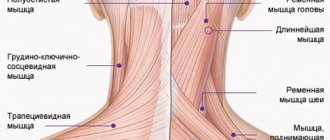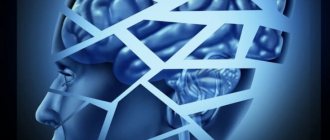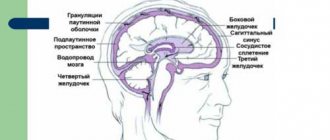Headaches are one of the most common reasons why patients turn to neurologists. All factors that cause such disorders are conventionally divided into 2 groups: organic (they can be seen on MRI images) and functional. MRI is performed specifically to detect organic abnormalities of the brain, which include:
- tumor formations;
- hydrocephalus (accumulation of cerebrospinal fluid in the ventricles of the brain);
- aneurysms, stenoses and other vascular lesions;
- sinusitis, sinusitis and other inflammatory phenomena in the paranasal sinuses;
- cerebral hemorrhage;
- inflammation of the brain and its membranes (encephalitis, meningitis);
- congenital pathologies of brain structures.
Very often, the root cause of the disease cannot be seen in the images, and then the doctor determines its etiology based on indirect signs.
Another cause of migraine may be cerebral circulatory disorders, for which an MRI procedure in angio mode is prescribed. For diagnostic accuracy, the ideal option is to do an MRI at the time of an attack, when you can assess the intensity of blood flow and identify acute circulatory disorders.
During the procedure, radiologists can detect the so-called. "cervical artery syndrome", which can affect one side or spread to both vessels. This entails paroxysmal pulsating headaches, provoked by compression of the cervical artery and aggravated by head movements. The root cause of this phenomenon is usually trauma.
How is MRI performed for migraine?
For complaints of recurrent headaches, MRI is prescribed to differentiate from severe organic brain lesions that have a structure similar to migraine. The pain caused by migraine cannot be eliminated with analgesics. Most often, people begin to uncontrollably take pills, which only worsen their condition.
When conducting a tomography study for migraine, the doctor follows a certain algorithm - scanning the brain, vascular bed, and cervical vascular system. If necessary, angiography data of the cervical vessels is added to this to assess the state of blood flow in the arteries.
On MRI images, migraine is manifested by multiple foci of ischemic origin, blood flow disturbances (recorded by a tomograph only during attacks). Immediately before a migraine attack, the blood vessels in the brain dilate, after which a sharp spasm occurs.
Migraine: by definition and essence
My head hurts unbearably. I have no strength to endure anymore. A full examination was completed: an MRI of the brain and its vessels, and the cervical spine was done. An ultrasound of the neck vessels was performed and even an encephalogram was taken. No changes were detected, but my head hurts.
With the neurologist at the Expert Kursk Clinic, Olesya Olegovna Bratchikova, we are talking about a disease that, today, is not diagnosed by the methods available to doctors. The topic of our conversation is migraine.
— Olesya Olegovna, what is migraine and how does it manifest itself?
This is a chronic pathology of the nervous system. Its leading symptom is repeated attacks of severe, often throbbing headaches. In a typical clinical picture, pain is noted on one side, i.e. in half of the head (side may change). Sometimes bilateral. Located in the forehead, temple, or eye socket. It intensifies with physical activity, head movements, and bending. The beginning is gradual. The pain increases, stabilizes, and subsides. A total attack can last from 4 hours to 3 days.
Read the material on the topic: “Cast iron” head: we understand the reasons
Migraine may also have other manifestations. Some of them: lack of appetite, nausea, less often - vomiting; loose stools, nasal congestion, intestinal colic. The face may be pale or, conversely, flushed.
A TOTAL ATTACK OF MIGRAINE CAN LAST FROM 4 HOURS TO 3 DAYS
With a migraine, a person is more sensitive to light or sound, and therefore tries to retire to a quiet place. The attack may be interrupted by sleep or vomiting.
— What do statistics say about this disease?
According to data, 80% of the world's inhabitants have experienced a migraine attack at least once in their lives. The debut occurs in the age range of 18-35 years. More common in women. Rare cases in children have been described. It also happens in people over 50 years of age. There is no gender dependence in this category.
- Why does migraine occur? What factors can provoke it?
The mechanism of development of pathology and the formation of its manifestations is associated with changes in vascular tone (constriction-dilation), as well as the nucleus of the trigeminal nerve. In the wall of the vessels to which this nerve approaches, substances are released that cause a limited, microbial-free inflammatory process. It also involves part of the dura mater. As a result, blood flow disturbance occurs. The result is pain.
Also important is the disruption of serotonin metabolism and metabolic processes in the neurons of the cerebral cortex.
ACCORDING TO THE DATA, 80% OF THE EARTH'S PEOPLE HAVE AN ATTACK AT LEAST ONCE IN THE LIFE.
Among the factors predisposing to migraine:
- heredity;
- hormonal changes (menstruation, ovulation, taking oral contraceptives);
- dietary habits (irregularity; consumption of certain foods - for example, chocolate, cheese, nuts, pickles and marinades. Not only their long-term consumption is important, but also their sudden cessation);
— bad habits (drinking alcohol);
- psychological factors (stress, or, conversely, relaxation after it, for example, on the weekend - “weekend headache”);
- taking certain medications (for example, nitroglycerin, reserpine, ranitidine);
- other factors (changes in weather, bright or flickering light, loud sound, strong odors, stuffy rooms, being at a height, injuries to the head and neck area);
- excess or lack of sleep.
How many hours a day does a person need to sleep? Olga Ivanovna Kuyantseva, a neurologist at Clinic Expert Voronezh LLC, tells the story.
— Migraines come in different forms. Tell us about the types of migraine and how they differ from each other?
The classification of this disease is extensive, and within the framework of our conversation it is inappropriate to present it in its entirety. In general, migraine without aura (simple) and with aura are distinguished.
Read the material on the topic: What kind of headache did Franz Kafka suffer from?
For example, migraine with visual aura includes signs such as flashing spots before the eyes, reduction or loss of visual fields.
With the so-called extended aura, manifestations can last up to 1 week.
MIGRAINE WITH VISUAL AURA INCLUDES SIGNS SUCH AS FLICKING SPOTS BEFORE THE EYES, REDUCTION OR LOSS OF VISUAL FIELDS
There is a variant of the disease that is more common in children and adolescents. With it, along with the visual aura, signs such as dizziness, decreased hearing, tinnitus, unsteadiness when walking, speech impairment, and depression of consciousness are noted.
Complications of migraine are also distinguished: status migraine, migraine infarction or stroke.
How to prevent a stroke? Director of the Scientific and Clinical Center for Neurology, Neuroreanimatology and Neurosurgery of the Orenburg State Medical University, Professor Vadim Ivanovich Ershov, talks about prevention
There are many types of migraine, and the final diagnosis and determination of its specific form is carried out only by a neurologist.
— Headache can be a sign of life-threatening illnesses. One of them is stroke. Do migraines and strokes have similar or different symptoms?
How to distinguish a migraine from a stroke? This is not always easy to do.
Migraine, unlike stroke, is more common in younger people. The frequency of attacks characteristic of migraine, the presence of cases of the disease in the family, and the absence of vascular risk factors (for example, previously diagnosed vascular aneurysms, high blood pressure, atherosclerosis, vascular stenosis, diabetes mellitus) are important.
DISTINGUISHING MIGRAINE FROM STROKE IS NOT ALWAYS EASY
Additional research methods (MRI, CT, angiography) play the main role in confirming/excluding stroke.
You can sign up for a brain MRI in your city here
— Is there a connection between migraine and stroke? Can it provoke a vascular accident?
Yes, there is a certain connection. One of the complications of migraine is migraine stroke. It develops primarily in migraine with aura (often a variant known as hemiplegic migraine).
ONE OF THE COMPLICATIONS OF MIGRAINE IS MIGRAIN STROKE
The criteria for migraine stroke are the persistence of focal neurological manifestations for more than 1 week, or the detection of a corresponding pathologically changed area in the brain during MRI or CT. You should also be alert to the addition of other symptoms that were not previously noted (for example, speech impairment, unsteadiness of gait, numbness in the arm and/or leg).
Read the material on the topic: What is the difference between ischemic and hemorrhagic stroke?
Risk factors (cardiovascular pathology, diabetes mellitus) are also important.
Thus, any headache requires a mandatory visit to a neurologist or calling an ambulance (depending on the situation). You can’t tolerate it and “wait it out.”
— Olesya Olegovna, can migraine be a mask for other dangerous diseases? For example, how can you differentiate a migraine from a brain tumor?
Yes. Similar symptoms may accompany a brain tumor.
There are similar manifestations in epilepsy, vascular malformations, vasculitis, and sinusitis.
An intense headache may be a symptom of meningitis. Yulia Vladimirovna Roshchupkina, a neurologist at Clinic Expert Tula, talks about the symptoms of the disease.
The distinction between diagnoses is made during examination, including neurological examination. The diagnosis of a tumor is confirmed/excluded using neuroimaging methods (MRI, CT).
— They say that it is impossible to cure migraines. This is true? Or are there effective treatment regimens and modern medicine can help patients with migraine?
Effective anti-migraine therapy has been developed (among other things, a relatively new method is used - botulinum therapy).
With the help of medications, it is possible to significantly reduce the frequency of attacks, and in some cases, the need for taking them disappears after a while. The patient may be free from attacks for a long time, but there is no guarantee that the migraine will not return.
— Any treatment begins with diagnosis. What is included in the “gold standard” examination of a patient with migraine?
Diagnosis is based on a detailed collection of complaints and anamnesis, with their detail. What matters are the characteristics of the pain, the presence of other symptoms, the age of onset of the pathology, hereditary burden, and the presence/absence of characteristic factors that provoke and alleviate the condition.
THERE ARE NO SPECIFIC LABORATORY TESTS OR INSTRUMENTAL METHODS CAPABLE OF CONFIRMING THE PRESENCE OF MIGRAINE
The peculiarity of this disease is that there are no specific laboratory tests or instrumental methods that can confirm the presence of migraine.
At the same time, if the doctor has prescribed additional examination methods, you should undergo them, even if as a result they do not obtain any evidence of pathology. Wouldn't it be a cause for joy to know that you don't have a life-threatening illness?
— What consequences can migraine lead to if it is not treated?
Complications may develop - status migraine (headache attack lasting more than 72 hours) and migraine stroke.
— What specialty doctor should a patient who is worried about migraine attacks seek help from?
The diagnosis of migraine is established only by a neurologist. If this is a simple migraine, and the patient does not have the opportunity to visit a neurologist in the future, then a general practitioner can further monitor the patient. If we are talking about migraine with aura, such patients are treated only by a neurologist.
You can make an appointment with a neurologist in your city here
Please note: the service is not available in all cities
Other materials on topics:
The Ultimate Guide to High Blood Pressure: Frequently Asked Questions
What is hidden behind the diagnosis of dyscirculatory encephalopathy?
It's off scale! Looking for reasons for high blood pressure
For reference:
Bratchikova Olesya Olegovna
In 2004 she graduated from the Faculty of General Medicine of Kursk State Medical University.
From 2004 to 2005, she completed an internship, and from 2005 to 2007, a clinical residency in the specialty “Neurology”.
I took a course in epileptology and certification courses.
Currently working as a neurologist at Clinic Expert Kursk. Receives at the address: st. Karl Liebknecht, no. 7.
Headaches after MRI
Although tomography is considered a completely safe procedure, many patients complain of increased headaches, often accompanied by nausea, general weakness, and dizziness.
Painful sensations are concentrated in the area of the back of the head or the crown. Doctors say that this phenomenon is associated with the increased sensitivity of migraine patients to external factors and is temporary. In most cases, this condition goes away within a day after the study, and pain of this nature is easily eliminated with pills. Therefore, you should not be afraid of the procedure.
If the pain does not go away after 24 hours, contact your doctor, who will conduct an examination and prescribe treatment. Usually in such a situation, neurologists recommend, in addition to medications, to drink less fluid, not to strain either mentally or physically (it is best to wait for the condition to stabilize at home, observing bed rest). MRI cannot cause any harm to health, since it is non-invasive and the safest of all hardware diagnostic methods existing today.
Where to get an MRI of the brain and how much does diagnostics cost?
Tomography is a paid but quite affordable procedure. Such devices are available in many specialized offices and clinics. You can choose any medical institution on our website and sign up for an examination at any time of the day: in the morning, in the evening or even at night, when many round-the-clock diagnostic rooms offer discounted promotional offers.
The price of an MRI of the brain when booking through our website starts from 1,500 rubles. In some clinics, the cost of the procedure reaches 5-6 thousand rubles. This depends on the type of tomograph, its accuracy and the pricing policy of the medical institution. But particular accuracy of the study is important when a tumor is suspected or surgery is planned. And for migraines, an examination on any MRI machine is sufficient to make a diagnosis.
Diagnostics
Diagnosis of migraine is carried out on the basis of collecting complaints and anamnesis of patients, examining the patient and talking with him. If the initial consultation does not allow you to accurately diagnose the disease or identify the causes of the pathology, the neurologist can give a referral for an extensive examination using modern diagnostic equipment:
- MRI of the neck and brain;
- CT scan of the brain;
- brain scinography;
- electroencephalography;
- duplex scanning of arteries;
- Doppler ultrasound.
Consultation with an ophthalmologist allows you to determine the condition of the fundus and cerebral vessels. The presence of migraine symptoms may indicate serious pathologies, so a thorough examination is mandatory. JSC "Medicine" (academician Roitberg's clinic) is equipped with the latest diagnostic equipment, allowing examination of any complexity. The clinic is located in the center of Moscow at 2nd Tverskoy-Yamskaya lane, 10, a five-minute walk from the Mayakovskaya metro station.
Migraine is often a symptom of more severe diseases, so high-quality diagnosis using modern diagnostic equipment is an effective way to timely detect pathologies. Timely detection of diseases and contacting qualified doctors is a prerequisite for recovery and full restoration of vital activity.
JSC "Medicine" (clinic of academician Roitberg) is a multidisciplinary center, which provides patients with the opportunity to easily consult with specialists in various fields of medicine.
Signs and aura
The signs of migraine are determined by the form of the pathology. There is no particular difference between the symptoms in men and women, but women have attacks more often. Experts distinguish migraine, the causes of which are different, with and without aura. Aura with hemicrania is a complex of neuropsychological symptoms caused by spasms of cerebral vessels at the initial stage of development of the next attack.
There are the following types of aura, classified according to the symptoms that appear:
- visual with characteristic glare, distortions, flashes in the eyes, loss of visual fields;
- auditory with characteristic auditory hallucinations, tinnitus;
- motor, manifested by difficulties when moving;
- sensory, characterized by changes in smell and taste;
- vestibular with dizziness and even falls;
- aphasic with speech impairment.
Migraine specialists consider two main forms: regular and pathological with neurological symptoms.
Hemicrania in children
Migraines in children appear in most cases due to overwork due to heavy workload at school. Another cause is hormonal changes due to puberty. If migraine occurs more often in women than in men, then in childhood, on the contrary, boys suffer from migraine attacks more often. It is very difficult to diagnose migraine in young children who cannot formulate their complaints clearly. Migraine medications for children and adolescents are prescribed based on examination data.
Make an appointment with a neurologist
“Clinic No. 1” in Moscow offers to visit a consultation with a neurologist. The multidisciplinary medical center is equipped with the latest medical equipment for high-quality diagnosis and treatment of many diseases. Patients are offered comfort and safety, advantageous service programs, and a flexible system of discounts. You can make an appointment by phone or through the form on the website.
Moscow, st. Krasnodarskaya, house. 52, bldg. 2
+7
We work on weekdays and weekends from 8.00 to 21.00
Hemicrania in women
Migraine is diagnosed, the symptoms of which in women depend on the cause much more often than in men. Among the main causes of attacks in women:
- changes in vascular tone under the influence of hormonal levels changing throughout the menstrual cycle. For some women, migraine pain occurs during bleeding, for others during ovulation. Migraine medication is prescribed taking into account the patient’s hormonal background and her age;
- pregnancy, during which the load on the pregnant woman’s circulatory system increases significantly. Treatment of migraine in pregnant women requires caution when choosing medications;
- menopause, with the onset of which the ratio of hormones in a woman’s body changes significantly.
Since migraine, the symptoms and treatment of which in women depend on the individual characteristics of the body, can appear unexpectedly, doctors recommend taking preventive measures. Prevention using traditional medicine, massage and other types of therapeutic effects can significantly reduce the risk of an attack.
Prevention
In severe forms of hemicrania, preventive drug therapy can be prescribed, the use of which can significantly reduce the frequency and intensity of attacks. A drug for the prevention of attacks of hemicrania is prescribed by a doctor solely based on the data of the examination and examination of the patient. Doctors at JSC "Medicine" (clinic of academician Roitberg) use certified drugs that combine high efficiency with safety for the health of patients.
An important role in prevention is played by giving up bad habits, normalizing exercise and rest, and minimizing emotional and physical stress. During pregnancy, preventive medications are not prescribed due to possible harm to the health of the fetus.
Symptoms
The main symptom of migraine is headache. The headache is usually on one side, the nature of the pain is throbbing. The sensations intensify when moving or changing body position. The pain can always be in the same place or change location even within the same attack.
In addition to pain, signs of the disease include:
- Vomiting and nausea without relief.
- Change in sensitivity.
- Visual impairment.
- Speech impairment.
- Photophobia.
- Acute reaction to noise and sounds.
The listed symptoms occur before an attack and are its original harbingers. This phenomenon is called an aura.
Get a headache diagnosis at Clinic No. 1
- Neurologist appointment
- MRI
- Electroencephalography
- Angiography
For one-time payment for services - 20% discount
Call
Risk factors
Risk factors for hemicrania are:
- genetic predisposition;
- age – most often the disease occurs in patients 30-39 years old;
- frequent stressful situations;
- some food products, including those of artificial origin or low quality;
- fasting or irregular, poor nutrition (diet);
- changing sleep patterns;
- weather changes or moving to a different climate zone;
- intense physical activity;
- taking medications.
Classification of hemicrania depending on symptoms
- Migraine headache without aura is defined by episodic headaches without neurological deficits.
- Cervical migraine with severe headaches due to impaired blood flow through the vertebral artery.
- Paroxysmal chronic, which is characterized by short-term pain repeated several times a day.
- The ocular one, which lasts no more than half an hour, appears due to circulatory disorders in the occipital part of the cerebral cortex.
- Ophthalmoplegic with characteristic gas motor disorders due to compression of the gas motor nerve and spasms of the artery supplying the nerve.
- Retinal with characteristic attacks of transient blindness due to spasms of retinal vessels.
- Afactual with speech disorders during severe pain.
- Basilar (rare), characterized by tinnitus, visual disturbances, incoordination, dizziness, loss of consciousness and severe prolonged pain. Most often, this variety occurs during puberty in girls.
- Abdominal, accompanied by nausea, diarrhea, vomiting and severe abdominal pain, occurs only in children.
- Hemplegic with short attacks, weakness in the body and limbs.
- “Beheaded” is distinguished by visual disturbances and is difficult to diagnose.
Only a qualified doctor after an examination can answer the patient’s question as to why the migraine appeared.
Causes
The reasons why hemicrania appears are still not fully understood. During the research, scientists determined the fact that predisposition to this disease is inherited. The disease, namely the characteristics of the nervous system, is transmitted by women who suffer from hemicrania much more often than men.
The main cause of attacks is said to be activation of the trigeminal nucleus, which alternately leads to spasm and subsequent dilation of the arteries of the brain. It has also been determined that a failure of seratonin metabolism in the central nervous system is involved in the formation of pain.
Predisposition appears when exposed to triggers or certain factors, which doctors have divided into 4 groups:
- psychological triggers, including stress, emotional and mental stress;
- external triggers, the list of which includes changes in atmospheric pressure, loud sounds, bright lighting, odors, stuffy atmosphere, etc.;
- physiological triggers, which include fatigue, insomnia, hormonal imbalances;
- food triggers. Doctors call alcohol and tyramine contained in many foods (citrus fruits, smoked meats, cocoa, cheese, nuts, chocolate, etc.) the main stimulants of hemicrania attacks.
An attack can also be caused by insufficient consumption of clean water and food, diet or caffeine withdrawal, traveling with a change in time zones, weather changes, menstrual cycles in women, relaxation after severe stress. Migraines can occur in men and women due to hormonal imbalances due to external factors, as well as due to prolonged abstinence during sexual activity.
Treatment
Migraine treatment is divided into two areas:
- relief of the patient’s condition during an attack;
- preventing the occurrence of new attacks.
Help during a seizure
At the first signs of an impending migraine attack, it is necessary to eliminate as quickly as possible all factors that can increase the pain:
- turn off the lights and TV, close the curtains;
- eliminate sources of extraneous sounds as much as possible;
- provide access to fresh, cool air;
- go to bed.
To prevent and relieve immediate pain attacks, painkillers of various groups are used:
- analgesics and non-steroidal anti-inflammatory drugs (analgin, ibuprofen, indomethacin and their analogs): used for mild attacks that do not affect a person’s daily life;
- combination drugs (codeine, tempalgin, solpadeine): prescribed for moderate attacks that have little effect on life activity;
- triptan drugs (amigrenin, sumamigren, zomig and others) are used if attacks interfere with normal life;
- hormonal drugs (dexamethasone): used for severe and prolonged migraines in combination with other medications.
Additionally, antiemetics (metoclopramide, cerucal) can be used.
Home remedies to prevent a migraine attack are used as an addition to the main therapy. Many patients benefit from:
- cold compress on forehead;
- rubbing essential oils into the temple area;
- infusion of chamomile, mint, lemon balm, lavender and other herbs that promote relaxation;
- acupressure on acupuncture points: at the base of the skull, between the eyebrows in the hollow above the bridge of the nose, on the back of the foot (the hollow between the first and second toes).
It is important to remember that these remedies do not replace primary therapy.
Treatment between attacks
Preventing the occurrence of attacks is no less important than relieving pain and nausea. Currently, various groups of drugs are used:
- beta-blockers (propranolol and drugs based on it);
- antidepressants (venlafaxine, milnacipran, etc.): have a good effect in the treatment of chronic pain, and also reduce the manifestations of depression characteristic of patients with frequent attacks;
- anticonvulsants (Depakine, topiramate): well tolerated and significantly reduce the frequency of exacerbations.
Medicines are used:
- if exacerbations occur more than 2 times a month;
- if attacks last more than 48 hours;
- with severe headache or complications.
In other cases, general preventive measures are sufficient.











